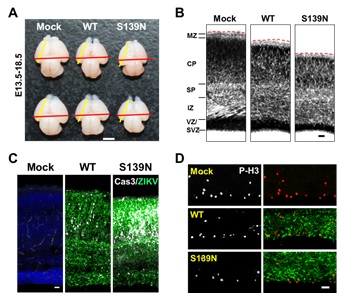First isolated from a sentinel monkey from the Zika forest, Uganda, in 1947 , Zika virus (ZIKV) was a neglected mosquito-borne flavivirus until its recent emergence in the Americas. In decades following its discovery, sporadic human ZIKV infections with mild signs and symptoms were reported in a few countries in Africa and Southeast Asia.
After several explosive outbreaks in Micronesia in 2007 and French Polynesia in 2013-2014, ZIKV rapidly swept through South and Central America in 2015.
Early in 2016, the World Health Organization declared the current ZIKV epidemics a Public Health Emergency of International Concern.
Zhiheng Xu's and Cheng-Feng Qin's group confirmed that ZIKV infection caused fetal microcephly firstly in previous research.
XU Zhiheng's group from the Institute of Genetics and Developmental Biology of the Chinese Academy of Sciences, collaborating with QIN Chengfeng's group from Academy of Military Medical Sciences, found that a single serine to asparagine substitution (S139N) in the viral polyprotein substantially increased Zthe neurovirulence of Zika virus, leading to more significant microcephaly in the mouse fetus, and thus contributed to the increased incidence of microcephaly in recent ZIKV epidemics.
They firstly found that three contemporary ZIKV strains from
Venezuela, Samoa and Martinique in 2015-2016, were more neurovirulent in mice than the ancestral strain CAM/2010.
The contemporary VEN/2016 strain caused a more significant microcephaly phenotype in embryonic brain than the ancestral strain CAM/2010, it showed significantly enhanced infection and replication in neuronal progenitor cells (NPCs), disrupting the proliferation and differentiation of NPCs and leading to NPCs apoptosis more significantly than the ancestral strain CAM/2010.
Then genome sequence alignment of ZIKV was performed. Using the ancestral strain CAM/2010 as a reference strain, it was found that the contemporary ZIKV strains harbor a series of conservative substitutions of amino acids throughout the genome. Seven of these substitutions were introduced into ZIKV genome to generate virus mutants by using reverse genetics approaches.
Of all the mutants, the S139N mutant virus exhibited the greatest neurovirulence in fetus and neonatal mice.
The coalescent analysis was then performed, revealing that the ZIKV S139N substitution firstly emerged in May, 2013, a few months before the 2013 outbreak in French Polynesia, and was then stably maintained in the epidemic strain during subsequent spread to the Americas. The emergence of the S139N substitution correlates with the emergence of reports of microcephaly case.
This research identified the critical neurovirulence determinant of ZIKV contributing to fetal microcephaly for the first time. The findings revealed the molecular mechanism of ZIKV infection induced microcephaly, which provided a reasonable explanation for the emerge of large microcephaly case in ZIKV epidemic and a direct answer to the riddle of rapid evolution of ZIKV.
Especially, the discovery of S139N mutant provided an important target for pathogen monitoring and risk prediction. These findings also lay a good foundation for studying on the pathogenesis of ZIKV and provided a good guide for vaccine and drug discovery.
This work was supported by the National Natural Science Foundation (NSFC) of China, the National Key Research and Development Project of China, the National Science and Technology Major Project of China, the Newton Advanced Fellowship from the UK Academy of Medical Sciences, Innovative Research Group and so on.
ZIKV S139N mutant causes more significant microcephaly (Image by IGDB)





